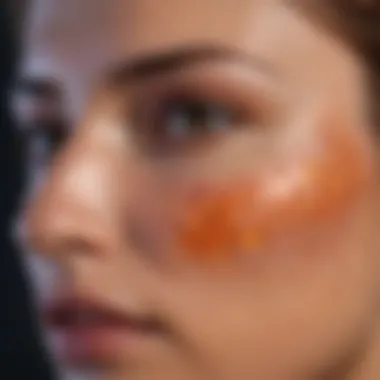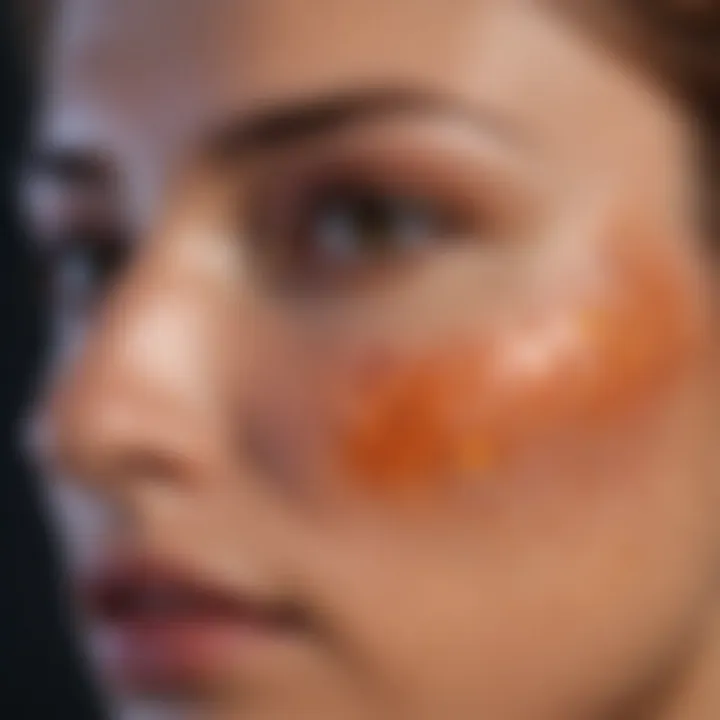Understanding UVA and UVB: Impact on Health and Environment


Intro
Ultraviolet (UV) radiation is a significant aspect of our environment, affecting both human health and the ecological balance. When discussing UV radiation, two key categories emerge: Ultraviolet A (UVA) and Ultraviolet B (UVB). Understanding these two types is crucial for both scientific inquiry and public health initiatives. This analysis seeks to unpack the complexities of UVA and UVB, their sources, biological impacts, and the measures necessary for protection against overexposure.
Recent Advances
Latest Discoveries
Recent research has illuminated many facets regarding the behavior and effects of UVA and UVB rays. For instance, studies have shown distinct biological mechanisms through which these rays interact with skin and other tissues. This includes groundbreaking insights into how UVA can penetrate deeper into the skin layers, contributing to photoaging and even certain cancers. Researchers are also exploring the role of Vitamin D synthesis in relation to UV exposure, balancing the positive and negative effects.
Technological Innovations
Technological advancements have played an integral role in understanding UV radiation. New devices and methods, such as portable UV sensors and improved spectroscopy, allow for real-time monitoring of UV levels. Additionally, advancements in sunscreen formulations have emerged, targeting both UVA and UVB protection more effectively. These innovations assist consumers in making informed choices to mitigate their risks.
"Education and awareness about UV exposure is key for public health, ensuring individuals understand when and how to protect themselves."
Biological Effects
The physiological consequences of UV radiation exposure are profound. UVA rays are primarily responsible for skin aging and wrinkling, whereas UVB rays are significant contributors to the development of skin cancers. These rays can cause direct damage to DNA, leading to mutations. The immune system is also affected, as UV exposure may suppress its function. This section will examine these biological processes in depth.
Implications for Health
Understanding the health effects of UVA and UVB rays is essential for formulating public health strategies. Skin cancer rates, particularly malignant melanoma, have risen alarmingly in recent years. Additionally, non-melanoma skin cancers pose significant health risks. Beyond skin-related issues, UV radiation has been linked to eye conditions, such as cataracts.
- Skin Cancer: Increases with both UVA and UVB exposure.
- Photoaging: Primarily caused by UVA.
- Cataracts: Associated with prolonged UV exposure.
Protective Measures
To combat the effects of UV radiation, various protective strategies are necessary. Awareness about using sunscreen designed to safeguard against both UVA and UVB is paramount. Besides topical applications, wearing protective clothing and seeking shade during peak hours can significantly reduce exposure. Moreover, educating the public about the importance of regular skin checks can facilitate early detection of potential issues.
Finale
Preamble to Ultraviolet Radiation
Ultraviolet (UV) radiation plays a significant role in both environmental science and human health. Understanding this form of radiation is crucial for various reasons. First, it provides insight into the broader context of how our environment affects our biological systems.
Exposure to UV radiation can lead to informative and sometimes serious biological responses. Knowledge of UV's characteristics helps individuals, researchers, and policymakers devise strategies for mitigation. The relevance of this section extends beyond mere awareness; it influences public health initiatives, legislation, and personal behavior towards sun safety.
Furthermore, comprehending UV radiation enriches our understanding of climate change and its effects on ecosystems. This understanding equips academia and industry alike with the tools to innovate protective technologies that safeguard public health and environmental integrity.
Definition of Ultraviolet Radiation
Ultraviolet radiation is a type of electromagnetic radiation with wavelengths shorter than visible light but longer than X-rays. Typically, UV radiation is classified into three primary categories based on wavelength: UV A, UV B, and UV C.
- UV A: Ranges from 320 to 400 nanometers, constituting about 95% of the UV radiation that reaches the Earth's surface. It penetrates deeper into the skin and is associated with skin aging and some forms of skin cancer.
- UV B: Ranges from 280 to 320 nanometers, comprising the remaining 5% of UV radiation reaching the Earth. It affects the superficial layers of skin and is primarily responsible for sunburns and the development of skin cancer.
- UV C: Ranges from 100 to 280 nanometers, but it is mostly absorbed by the Earth's atmosphere and does not reach the surface. However, it is present in artificial sources like germicidal lamps.
In summary, UV radiation is defined by its wavelength and energy levels, and it varies in its biological effects based on the specific type involved.
Historical Context of Ultraviolet Research
The study of ultraviolet radiation has evolved significantly since its discovery. In the late 19th century, scientists recognized that sunlight could produce effects beyond visible light. Early research focused on the biological impact of UV on human health, particularly skin responses to sunlight.


As technology advanced, the understanding deepened. The development of UV lamps and the recognition of their applications, from sterilization to skin treatments, further broadened the scope of research. However, with such advancements came concerns regarding overexposure and potential health risks, leading to intensified investigations into protective measures.
The historical trajectory of ultraviolet research underscores the dual nature of UV radiation. On one hand, it offers therapeutic benefits; on the other, it poses health hazards. This nuanced understanding continues to shape the direction of future studies, emphasizing the need for balance in the utilization and protection from UV radiation.
Classification of Ultraviolet Rays
Understanding the classification of ultraviolet rays forms the foundation of the comprehensive analysis of UV radiation. By categorizing these rays, researchers and health professionals can better assess their specific impacts on biological systems and the environment. The classification reveals essential properties that differentiate UV A and UV B, which can guide protective measures and public awareness.
Overview of UV Spectrum
The ultraviolet spectrum is a segment of the electromagnetic spectrum that lies between visible light and X-rays. It is divided into three primary categories: UV A, UV B, and UV C.
- UV A (320-400 nm): This type has the longest wavelengths and is not absorbed by the ozone layer. It accounts for approximately 95% of UV radiation reaching the Earth's surface.
- UV B (280-320 nm): This category has shorter wavelengths and is partially absorbed by the ozone layer. It constitutes about 5% of UV radiation that reaches the ground.
- UV C (100-280 nm): This variant is completely absorbed by the ozone layer and does not reach the Earth's surface, thus posing no threat to human health under natural conditions.
The distinction between these types is critical for understanding their respective biological effects and potential risks. Each category influences skin health, eye conditions, and overall ecological balance.
Characteristics of UV A
UV A rays penetrate deeply into the skin. They can lead to skin aging and contribute to the development of skin conditions like photoaging and some forms of skin cancer.
- Wavelength: Ranges between 320 to 400 nm.
- Energy: Lower energy compared to UV B but more prevalent in sunlight.
- Effects on DNA: UV A affects the DNA in skin cells, potentially leading to mutations over time.
The long-term exposure to UV A is a concern for dermatologists and health experts. It raises awareness about the need for effective sun protection, especially for individuals spending extended hours outdoors.
Characteristics of UV B
UV B rays, while less abundant than UV A, have a higher energy and are primarily responsible for sunburn and adverse skin reactions.
- Wavelength: Ranges from 280 to 320 nm.
- Energy: Higher energy level, which allows them to cause direct damage to DNA in skin cells.
- Vitamin D Synthesis: UV B is crucial for the synthesis of vitamin D, an essential nutrient for calcium absorption and bone health.
Many studies link UV B exposure directly to the development of melanoma and other skin cancers. Therefore, it is important for the public to understand the implications of UV B light and adopt appropriate preventive measures when exposed to sunlight.
Understanding the unique characteristics of UV A and UV B helps shape effective public health approaches and personal protective strategies. It is crucial for ensuring both health safety and environmental conservation.
Physical Properties of UV A and B
Examining the physical properties of Ultraviolet A (UV A) and Ultraviolet B (UV B) rays sheds light on their unique characteristics and significance. Understanding these properties is crucial because it forms the foundation for assessing their impact on both human health and the environment.
Wavelengths and Energy Levels
UV A and UV B differ primarily in their wavelengths and energy levels. UV A has a wavelength range of 320 to 400 nanometers, while UV B ranges from 280 to 320 nanometers. This difference has significant implications.
- Energy Levels: UV A rays have lower energy compared to UV B rays. The relationship between wavelength and energy means shorter wavelengths, such as those of UV B, carry more energy. The greater energy levels of UV B contribute to its higher biological effects, such as skin damage and burnt skin.
- Penetration: UV A can penetrate deeper into the skin layers than UV B. This characteristic leads to its role in photoaging, yielding long-term skin damage.
In summary, understanding the wavelengths and energy levels of UV A and UV B is key for developing protective strategies and better grasping their health implications.
Sources of UV A and B
The sources of UV A and B include both natural and artificial origins. Understanding these sources helps in evaluating exposure levels and potential risks.
- Natural Sources: The sun is the primary source of both UV A and B radiation. About 95% of the UV radiation that reaches the Earth’s surface is UV A, while the remaining 5% is UV B. Factors such as time of day, geographical location, and season significantly affect UV radiation exposure from sunlight.
- Artificial Sources: Various human-made sources also emit UV rays. Common examples include:
- Tanning Beds: These primarily emit UV A rays, which can lead to increased skin damage.
- Mercury Vapor Lamps: Often used in commercial and industrial settings, they emit both UV A and UV B radiation.
- Fluorescent Lights: Certain types of fluorescent lamps also emit low levels of UV A and B.


By identifying the sources of UV A and B, individuals can take informed steps to mitigate exposure and minimize related health risks. Understanding these aspects is essential not only for personal health but for community health initiatives as well.
"Awareness of UV sources allows better protection strategies against potential health risks."
Biological Effects of UV Radiation
Ultraviolet (UV) radiation plays a critical role in various biological processes, both beneficial and harmful. Understanding the biological effects of UV radiation provides key insights into health impacts, ecological consequences, and the overall balance of life on Earth. This section highlights the importance of examining UV radiation effects on human health, as well as the implications of these effects on ecosystems.
Impact of UV A on Human Biology
Ultraviolet A (UV A) rays are a major component of sunlight, comprising about 95% of the UV radiation that reaches the Earth's surface. UV A penetrates the skin more deeply than UV B and is primarily responsible for premature skin aging, such as wrinkles and loss of elasticity. Furthermore, chronic UV A exposure can lead to DNA damage within skin cells, which is associated with the development of skin cancers over time.
One significant biological effect of UV A is its role in the photoaging process. This type of aging is characterized by changes such as thickening of the skin, reduced moisture, and increased risk for the development of skin malignancies.
Additionally, UV A exposure influences vitamin D synthesis in the body, which is essential for maintaining bone health and supporting immune functions. However, maintaining balance is key; excessive exposure can bring a range of negative effects.
Impact of UV B on Human Biology
Ultraviolet B (UV B) occupies a different niche in the spectrum of UV radiation. These rays are mainly responsible for sunburn and have a higher energy level compared to UV A. They can damage the DNA in skin cells more directly, leading to an increased risk of developing skin cancers, particularly melanoma.
One of the significant impacts of UV B on human biology lies in its stimulation of melanin production, which helps protect the skin. This natural pigment darkens the skin in response to sun exposure, acting as a defense mechanism against harmful rays. However, excessive UV B exposure can overwhelm this protective mechanism, resulting in sunburn, inflammation, and long-term skin damage.
Moreover, UV B is an important factor in vitamin D production, as it initiates its synthesis in the skin. This makes it crucial for maintaining health; however, the challenge here involves striking a balance. The benefits of vitamin D need to be weighed against the risks associated with UV B overexposure.
Potential Health Risks Associated with UV Radiation
Both UV A and UV B radiation pose potential health risks that can have significant implications for individuals. Some of the most notable risks include:
- Skin Cancer: One of the main concerns related to UV radiation is its strong association with various types of skin cancer. This includes basal cell carcinoma, squamous cell carcinoma, and malignant melanoma.
- Immune System Suppression: UV exposure can alter the immune response, potentially reducing the ability to fight infections and diseases.
- Eye Damage: Prolonged exposure can lead to cataracts and other eye disorders, affecting vision over time.
- Premature Aging: Both UV A and UV B contribute to skin changes that are characteristic of photoaging.
"Understanding and mitigating the effects of UV radiation is essential for reducing health risks and ensuring well-being in our environment.”
Environmental Implications of UV Radiation
The environmental implications of ultraviolet (UV) radiation are profound and often underestimated. Both UV A and B rays influence ecosystems and play a crucial role in the delicate balance of nature. These rays affect various biological processes in plants and animals, making it essential to understand their broader environmental impact.
Effects of UV on Ecosystems
UV radiation penetrates the atmosphere and reaches Earth's surface, affecting terrestrial and aquatic ecosystems. The consequences of increased UV exposure can be significant:
- Primary Productivity: In aquatic ecosystems, phytoplankton serve as the foundation of the food web. Increased UV radiation can damage these organisms, reducing their photosynthetic efficiency and, in turn, affecting the entire marine food chain.
- Aquatic Life: Organisms such as fish and amphibians are susceptible to increased UV radiation. Changes in UV exposure can lead to mutations, reduced reproductive success, and altered behavior in these species.
- Terrestrial Flora: Plant species use UV light for various physiological processes. However, excessive UV exposure can result in damage to plant leaves, reducing growth rates and overall health. This disruption can influence entire ecosystems, as primary producers are affected.
It is crucial to consider how UV radiation interacts with ecosystem dynamics. Higher UV levels can lead to shifts in species composition and nutrient cycling.
UV Radiation and Climate Change
The connection between UV radiation and climate change is becoming clearer. As the ozone layer continues to thin due to pollutants, more UV rays reach the surface. This not only poses risks to health and biodiversity but also exacerbates climate change.
- Feedback Loops: Increased UV exposure can stress plant life, particularly in sensitive regions. Reduced vegetation affects carbon sequestration, further contributing to atmospheric greenhouse gas levels.
- Interactions with Climate Systems: Changes in UV radiation can influence weather patterns and atmospheric conditions. For instance, UV can affect cloud formation and precipitation patterns, leading to altered climate conditions.
- Policy Implications: Policymakers must consider the implications of UV radiation when addressing climate change. Regulations aimed at reducing atmospheric pollutants must also include strategies to protect the ozone layer, which acts as a shield against harmful UV radiation.
In summary, understanding the environmental implications of UV radiation is vital. The effects on ecosystems and their interconnectedness with climate change should not be overlooked. Comprehensive knowledge in this area can inform both public health guidance and environmental policies.


Mitigation Strategies for UV Exposure
The significance of mitigation strategies for UV exposure is manifold. In recent years, awareness regarding the risks associated with UV radiation has increased. This is crucial, especially for populations who spend extended periods outdoors or live in areas with high UV index levels. Effective mitigation can protect human health, reduce skin cancer cases, and also shield ecosystems from the detrimental effects of UV rays. By implementing specific strategies, individuals and governments can foster a safer environment.
Personal Protective Measures
Personal protective measures are the first line of defense against harmful UV radiation. These include wearing protective clothing, using sunscreen, and seeking shade during peak UV hours.
- Protective Clothing: Denser fabrics that cover as much skin as possible can significantly reduce exposure. Many brands now offer clothing specifically designed with UV protection in mind.
- Sunscreen: The consistent use of broad-spectrum sunscreen can be very effective. It is important to choose a product with an SPF of at least 30 and to reapply it every two hours or after swimming or sweating.
- Shade: Seeking shade is critical, especially during midday when the sun's rays are the strongest. Umbrellas, canopies, and natural shade from trees can provide good shelter from UV exposure.
Maintaining these habits not only helps in direct protection but also promotes a culture of UV safety among peers and family.
Policy and Public Health Initiatives
On a broader scale, policy and public health initiatives play a pivotal role in combating UV exposure across communities. Governments and health organizations can implement programs that address UV radiation risks effectively.
- Education Programs: Initiatives aimed at educating the public about UV exposure and its dangers can increase awareness and encourage protective measures.
- Sun Safety Policies: Encouraging schools and workplaces to adopt sun safety policies can lead to more comprehensive protection measures. This includes creating sun-safe environments through landscaping and scheduling outdoor activities during safer hours.
- Regulation of Tanning Beds: Limiting the use of tanning beds and promoting bans where possible can help in reducing preventable skin cancers.
Overall, collaboration between public health entities and community stakeholders is vital. With combined efforts in education and regulation, significant strides can be made in reducing the impacts of UV exposure.
"Awareness and proactive measures can substantially reduce the health risks associated with UV exposure, fostering a culture of safety and health."
Future Directions in UV Research
The landscape of UV research is evolving, offering new insights and advancements that will shape the way we understand ultraviolet A and B rays. Recognizing the dual nature of UV radiation is vital for future studies. A comprehensive investigation into how these rays interact with biological systems, technological advancements, and environmental implications will enhance human and ecosystem health.
Advancements in Protective Technologies
Developments in protective technologies are essential for minimizing risks associated with UV exposure. Researchers are focusing on products like enhanced sunscreen formulations, which offer superior protection while being environmentally friendly. Innovations in clothing that provide UV resistance are also on the rise, with companies like Columbia Sportswear producing fabrics that block out harmful rays.
The role of technology in protecting against UV radiation extends to architectural advancements as well. For instance, tinted window films and specialized coatings can significantly reduce UV penetration in buildings, improving indoor safety. These advancements facilitate more informed choices for consumers and professionals alike.
Emerging Studies on UV Effects
The recent surge in studies examining the effects of UV radiation on health and the environment underlines the need for a deeper understanding of its implications. New research suggests that the impact of UV radiation goes beyond skin cancer, influencing conditions like immune suppression and vitamin D synthesis.
Moreover, studies are increasingly focusing on the role of UV radiation in climate change. It is essential to understand how UV rays interact with atmospheric components and contribute to ecological shifts. Such research opens pathways for developing policy recommendations aimed at mitigating adverse outcomes.
Advancements in analytical techniques, including spectral analysis and smart sensors, provide new avenues for studying UV effects. As scientists unearth data on UV radiation's long-term impacts, it is crucial for both public health and environmental policies to adapt accordingly.
"Understanding the variances in UV radiation effects across different ecosystems is key to crafting effective protective policies."
As society progresses, research must continue to adapt and expand, addressing the pressing questions surrounding the interaction between UV radiation and various biological and ecological processes.
Finale
The discussion surrounding ultraviolet (UV) radiation, specifically UV A and UV B, carries substantial weight as it encapsulates vital health and environmental aspects that affect our daily lives. This section emphasizes the interconnected nature of knowledge, personal responsibility, and broader societal actions that can alleviate risks associated with UV exposure.
Summary of Key Points
- Understanding UV Types: Recognizing the distinctions between UV A and UV B rays is fundamental. UV A penetrates deeply into the skin, contributing to aging and some types of skin cancer, while UV B is primarily responsible for sunburn and direct skin damage.
- Biological Impact: Knowledge of the biological effects of both UV A and UV B can guide preventive measures. Each type has different, yet significant implications on human health, necessitating careful observation and awareness.
- Environmental Effects: The implications of UV radiation extend beyond human health, influencing ecosystems and biodiversity. Understanding these effects is crucial for developing policies that mitigate harmful exposure.
- Protective Strategies: Personal and collective measures are important for reducing UV exposure. Utilizing protective clothing and sunscreen, alongside advocating for public health initiatives, exemplifies proactive coping strategies.
- Future Research Directions: Emerging studies continue to shed light on the long-term effects and evolving methods for protection against UV radiation.
The Importance of Awareness and Research
Raising awareness about UV radiation and its effects is not merely an academic exercise; it is a societal necessity. By fostering a deeper understanding, individuals are better equipped to take personal protective measures against UV exposure. Furthermore, ongoing research is critical for developing innovative strategies to tackle the consequences of increased UV radiation due to environmental changes and ozone depletion.
- Increased public education on proper sun safety can minimize the risk of skin cancer.
- Financial investments in UV research can lead to advancements in both preventive technology and treatment protocols for UV-related health issues.
To summarize, collective awareness and diligent research form the backbone of informed action against the implications of UV radiation. Understanding UV A and UV B radiation is not just an academic exploration; it forms a vital component of public health policy and personal well-being.















